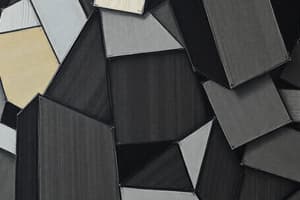Podcast
Questions and Answers
A right triangular prism has a base with sides 3 cm, 4 cm, and 5 cm and a height of 10 cm. What is its volume?
A right triangular prism has a base with sides 3 cm, 4 cm, and 5 cm and a height of 10 cm. What is its volume?
- 60 cm (correct)
- 300 cm
- 30 cm
- 120 cm
What distinguishes a right prism from an oblique prism?
What distinguishes a right prism from an oblique prism?
- The number of lateral faces.
- The angles of their lateral faces relative to the bases. (correct)
- The shape of their bases.
- The overall volume of the prism.
A cylinder has a radius of 5 cm and a height of 8 cm. Determine its lateral surface area.
A cylinder has a radius of 5 cm and a height of 8 cm. Determine its lateral surface area.
- $80\pi \ cm^2$ (correct)
- $40\pi \ cm^2$
- $130\pi \ cm^2$
- $25\pi \ cm^2$
If the radius of a cone is doubled while the height remains constant, how does the volume change?
If the radius of a cone is doubled while the height remains constant, how does the volume change?
Which of the following statements is NOT true about the relationship between a cone and a cylinder with the same base radius and height?
Which of the following statements is NOT true about the relationship between a cone and a cylinder with the same base radius and height?
A rectangular prism has dimensions 6 cm x 8 cm x 10 cm. What is its surface area?
A rectangular prism has dimensions 6 cm x 8 cm x 10 cm. What is its surface area?
How does the volume of an oblique cylinder compare to a right cylinder with the same radius and height?
How does the volume of an oblique cylinder compare to a right cylinder with the same radius and height?
A cone has a radius of 3 cm and a height of 4 cm. What is its slant height?
A cone has a radius of 3 cm and a height of 4 cm. What is its slant height?
What is the effect on the surface area of a cylinder if both its radius and height are doubled?
What is the effect on the surface area of a cylinder if both its radius and height are doubled?
Which of the following is a necessary condition for a solid to be classified as a prism?
Which of the following is a necessary condition for a solid to be classified as a prism?
The base of a prism is a regular hexagon with side length 4 cm. The height of the prism is 12 cm. Find the volume of the prism.
The base of a prism is a regular hexagon with side length 4 cm. The height of the prism is 12 cm. Find the volume of the prism.
A cylinder has a volume of $100\pi \ cm^3$ and a height of 4 cm. What is the radius of its base?
A cylinder has a volume of $100\pi \ cm^3$ and a height of 4 cm. What is the radius of its base?
A cone has a slant height of 13 cm and a radius of 5 cm. What is its volume?
A cone has a slant height of 13 cm and a radius of 5 cm. What is its volume?
A prism has a base area of 25 cm and a height of 8 cm. If the height is doubled, how does the volume change?
A prism has a base area of 25 cm and a height of 8 cm. If the height is doubled, how does the volume change?
Which of the following is always true for a right prism?
Which of the following is always true for a right prism?
If the diameter of the base of a cylinder is equal to its height, and the volume is $128\pi$, what is the height of the cylinder?
If the diameter of the base of a cylinder is equal to its height, and the volume is $128\pi$, what is the height of the cylinder?
A cone and a cylinder have the same base radius and height. If the volume of the cylinder is $90 \ cm^3$, what is the volume of the cone?
A cone and a cylinder have the same base radius and height. If the volume of the cylinder is $90 \ cm^3$, what is the volume of the cone?
What effect does doubling both the radius and the height of a cone have on its volume?
What effect does doubling both the radius and the height of a cone have on its volume?
A right square prism has a volume of 432 $cm^3$. If the base edge length is 6 cm, find the height of the prism.
A right square prism has a volume of 432 $cm^3$. If the base edge length is 6 cm, find the height of the prism.
Flashcards
What are solids?
What are solids?
Three-dimensional geometric shapes.
What are prisms?
What are prisms?
Solids with two parallel, congruent bases connected by lateral faces that are parallelograms.
What is a right prism?
What is a right prism?
Prism with lateral faces perpendicular to the bases.
What is an oblique prism?
What is an oblique prism?
Signup and view all the flashcards
Volume of a prism
Volume of a prism
Signup and view all the flashcards
Surface area of a prism
Surface area of a prism
Signup and view all the flashcards
What are cylinders?
What are cylinders?
Signup and view all the flashcards
What is a right cylinder?
What is a right cylinder?
Signup and view all the flashcards
What is an oblique cylinder?
What is an oblique cylinder?
Signup and view all the flashcards
Volume of a cylinder
Volume of a cylinder
Signup and view all the flashcards
Surface area of a cylinder
Surface area of a cylinder
Signup and view all the flashcards
What are cones?
What are cones?
Signup and view all the flashcards
What is a right cone?
What is a right cone?
Signup and view all the flashcards
What is an oblique cone?
What is an oblique cone?
Signup and view all the flashcards
Volume of a cone
Volume of a cone
Signup and view all the flashcards
Surface area of a cone
Surface area of a cone
Signup and view all the flashcards
Cone vs Cylinder Volume
Cone vs Cylinder Volume
Signup and view all the flashcards
Study Notes
- Solids are three-dimensional geometric shapes.
Prisms
- Prisms are solids with two parallel, congruent bases connected by lateral faces that are parallelograms.
- The bases determine the name of the prism (e.g., triangular prism, rectangular prism).
- Right prisms have lateral faces that are perpendicular to the bases.
- Oblique prisms have lateral faces that are not perpendicular to the bases.
- Volume of a prism: V = Bh, where B is the area of the base and h is the height (perpendicular distance between the bases).
- Surface area of a prism: SA = 2B + Ph, where B is the area of the base, P is the perimeter of the base, and h is the height of the prism.
Cylinders
- Cylinders are solids with two parallel, congruent circular bases connected by a curved lateral surface.
- A right cylinder has bases that are aligned directly above each other.
- An oblique cylinder has bases that are not aligned directly above each other.
- Volume of a cylinder: V = πr²h, where r is the radius of the base and h is the height (perpendicular distance between the bases).
- Surface area of a cylinder: SA = 2πr² + 2πrh, where r is the radius of the base and h is the height.
Cones
- Cones are solids with a circular base and a single vertex (apex) not on the base.
- A right cone has its vertex directly above the center of the circular base.
- An oblique cone has its vertex not directly above the center of the circular base.
- Volume of a cone: V = (1/3)πr²h, where r is the radius of the base and h is the height (perpendicular distance from the base to the vertex).
- Surface area of a cone: SA = πr² + πrl, where r is the radius of the base and l is the slant height (distance from the vertex to any point on the edge of the base).
- The slant height (l) can be found using the Pythagorean theorem: l² = r² + h².
Relationships Between Solids
- A cone's volume is 1/3 the volume of a cylinder with the same base radius and height.
- Prisms and cylinders both have a constant cross-sectional area along their height.
Studying That Suits You
Use AI to generate personalized quizzes and flashcards to suit your learning preferences.




